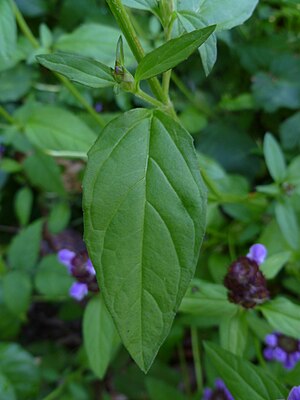Note: This is a project under development. The articles on this wiki are just being initiated and broadly incomplete. You can Help creating new pages.
Difference between revisions of "Prunella vulgaris - Self heal"
(Created page with "thumb|right|''Prunella vulgaris'', ''self-heal'' '''Prunella vulgaris''' (known as '''common self-heal''' or '''heal...") |
Chaithrika (talk | contribs) (+Common names) |
||
| Line 20: | Line 20: | ||
*Heal-all is edible, and can be used in salads, soups, stews, and boiled as a pot herb. | *Heal-all is edible, and can be used in salads, soups, stews, and boiled as a pot herb. | ||
*The plant contains vitamins A, C, and K, as well as flavonoids and rutin.<ref name="uses"/> | *The plant contains vitamins A, C, and K, as well as flavonoids and rutin.<ref name="uses"/> | ||
| + | |||
| + | ==Common name== | ||
| + | |||
| + | * '''English''' - Herbaceous plant | ||
== References == | == References == | ||
Revision as of 12:40, 8 March 2017
Prunella vulgaris (known as common self-heal or heal-all) is an herbaceous plant in the genus Prunella.
Self-heal is edible: the young leaves and stems can be eaten raw in salads; the plant in whole can be boiled and eaten as a potherb; and the aerial parts of the plant can be powdered and brewed in a cold infusion to make a beverage.[Clarification needed]
Description
Prunella vulgaris grows 5 to 30 cm high (2-12inches), with creeping, self-rooting, tough, square, reddish stems branching at leaf axis.[1]
The leaves are lance shaped, serrated, and reddish at tip, about 2.5 cm (1 inch) long and 1.5 cm (half an inch) broad, and growing in opposite pairs down the square stem. Each leaf has 3-7 veins that shoot off of the middle vein to the margin. The stalks of the leaves are generally short, but can be up to 5 cm (2 inches) long.[2]
The flowers grow from a clublike, somewhat square, whirled cluster; immediately below this club are a pair of stalkless leaves standing out on either side like a collar. Flowers are two lipped and tubular. The top lip is a purple hood, and the bottom lip is often white; it has three lobes with the middle lobe being larger and fringed upwardly. Flowers bloom at different times depending on climate and other conditions, but mostly in summer (from June to August in the USA).
Self-heal propagates both by seed and vegetatively by creeping stems that root at the nodes.[3]
Uses
Topically, a poultice of the plant is applied to irritated skin, as a disinfecting agent and to pack wounds in the absence of other wound-care material. It was considered by the Chinese to "change the course of a chronic disease".
- Heal-all is edible, and can be used in salads, soups, stews, and boiled as a pot herb.
- The plant contains vitamins A, C, and K, as well as flavonoids and rutin.[4]
Common name
- English - Herbaceous plant
